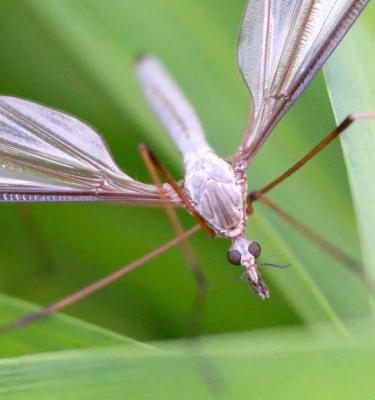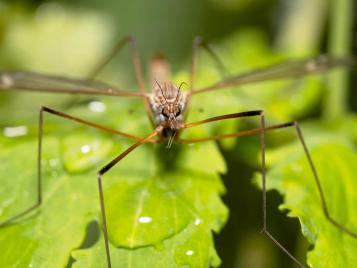

How to Identify & Get Rid of Crane Flies
What are crane flies?
Crane flies, also familiar as ‘daddy longlegs’ in the UK, are a type of large fly. The most commonly seen crane fly in the UK has a very slender body which is light greyish brown in colour, with even longer, spindly legs.
They are attracted to light and may sneak into the warmth of a house, where they are difficult to ignore as they bump around the ceiling trying to find a way back outside again. Craneflies are often seen at dusk and at night-time in late summer and autumn. At this adult stage of life, they do not cause problems in the garden.
However, as a juvenile, the crane fly larvae – also known as leatherjacket – is a destructive garden pest. Crane fly larvae are thick-skinned, olive-brown coloured insects about 3cm (1”) long. These leatherjacket bugs feed on plant roots and are particularly attracted to grass, meaning trouble for your lawn.
How to identify crane flies from mosquitoes
Mosquitoes and crane flies are of a similar shape, and this is where it is easy to confuse them. Despite the close appearance, crane flies are much larger than mosquitos and have just one pair of wings, whereas mosquitos have two pairs. When still, the crane fly allows its wings to spread out, whereas a mosquito when resting or feeding will keep its wings folded against its body.
Crane flies are sometimes called ‘mosquito hawks’, which is a bit misleading, as they are only distantly related and do not prey on mosquitoes. In fact, despite a well-circulated myth to the contrary, crane flies are completely harmless to any living being. Crane flies are not harmful. They do not have teeth or poison, and as they have a short lifespan of less than two weeks, they simply do not need to feed. A female mosquito on the other hand, can and often does bite to obtain nutrients and protein. Mosquitos will often hang around indoors wherever there is something to feed on - be that a human, pet or a houseplant. Crane flies on the other hand often find their way indoors accidentally, and will be happy to move outside again with a little encouragement.
Both are found in tropical and sub-tropical areas, although crane flies are found more widely, even in sub polar regions. Both enjoy grassy habitats and open water.

Types of crane flies in the UK
There are over 300 species of crane fly in the UK, and thousands worldwide. Any member of the Tipulidae family is considered a crane fly, although the most common species found in this country are the Tipula Paludosa and Tipula oleracea. Other species which you might come across in the UK are:
- Ctenophora pectinicornis
- Dictenidia bimaculata
- Nephrotoma appendiculata (also known as the Spotted Crane Fly)
- Nephrotoma crocata
- Nephrotoma flavescens (also known as the Tiger Crane Fly)
- Nephrotoma flavipalpis
- Nigrotipula nigra
- Tipula confusa
- Tipula fascipennis
- Tipula lunata
- Tipula luteipennis
- Tipula maxima
The larvae of all of these species of crane fly are known as leatherjackets. It is these bugs which can damage your lawn.
How do crane flies damage your lawn?
The first sign that you may have a crane fly problem are patches of brown turf in an otherwise beautiful green lawn. This damage is caused by an infestation of crane fly larvae munching away on the roots of the grass, which then dies off.
A lawn may also feel spongey in places. This is where leatherjackets have disturbed the soil and grass roots, loosening the surface.
Look for rusty brown pupal cases sticking out from the lawn surface. These are left by the emerging crane fly. You may notice more birds than usual pecking at the lawn as they try to feed on the plump cranefly bugs. This can also make the lawn unsightly.
Although grass is the usual victim of hungry crane fly larvae, leatherjackets can threaten any plant from border plants and herbs to hedges. Both roots and other parts of a plant close to the soil surface can be affected.
It is important to tackle a crane fly/leatherjacket infestation promptly, as it is likely to spread if untreated.
How to get rid of crane flies?
There is no known poison or chemical control for cranefly larvae, but nematodes (Steinernema feltiae or Steinernema carpocapsae) can be applied to kill leatherjackets naturally. Hand picking cranefly larvae from the lawn is another option, although this is laborious and needs to be repeated several times. To do this, cover the affected part of the lawn over night, when they are most active, returning in the morning to remove and destroy the larvae.
Prevention is easier than cure to get rid of leatherjackets. Dissuade adult crane flies from laying eggs in your lawn by not watering or lighting it more than strictly necessary. If the lawn must be watered, do so in the morning when moisture will not persist overnight. Do not light the lawn, either with outdoor lights or by allowing light to shine from the home. Craneflies are most active in the evening, when they seek an easy place to lay their eggs.
Keep your lawn in good health by mowing, aerating and removing thatch regularly. This means that the grass can better withstand and recover from attacks. Apply a nitrogen-rich grass feed in the spring to encourage growth, and apply again after a leatherjacket problem has been treated, to help the grass to repair itself.












